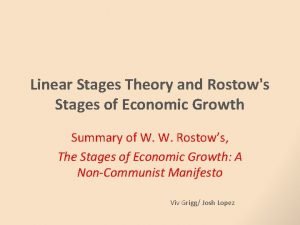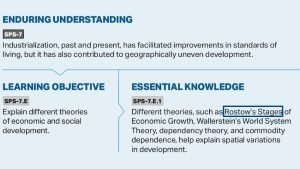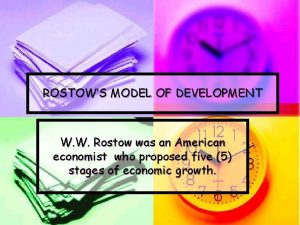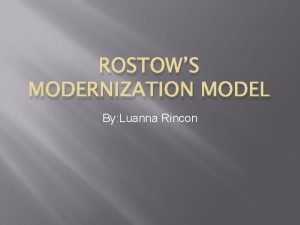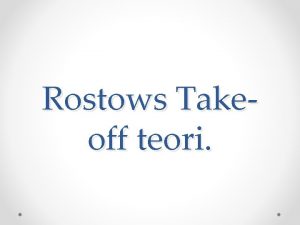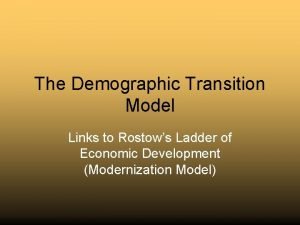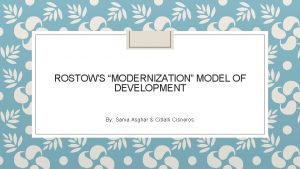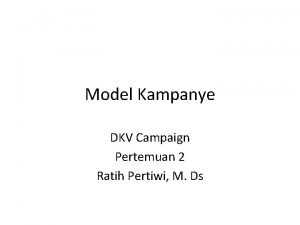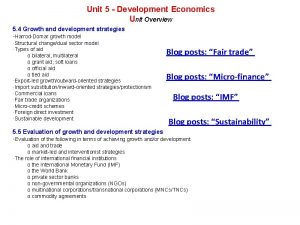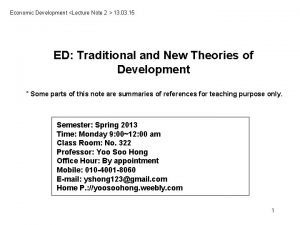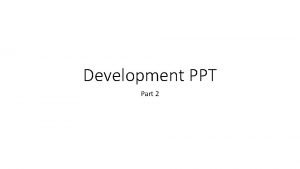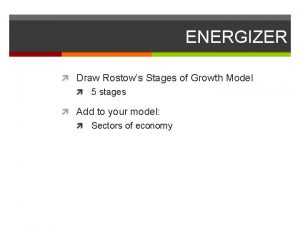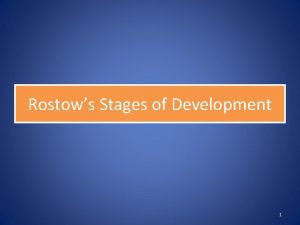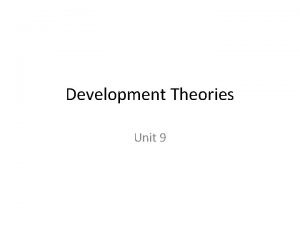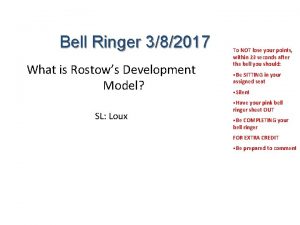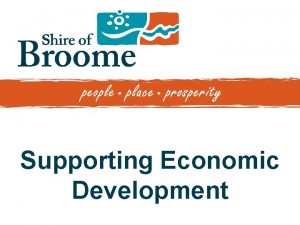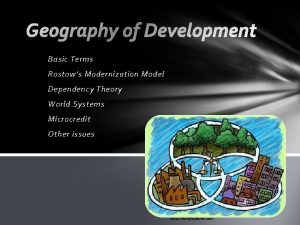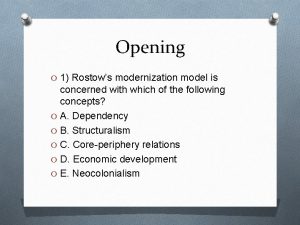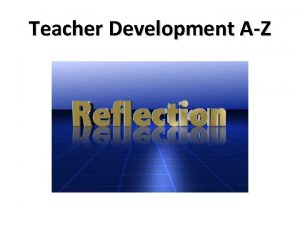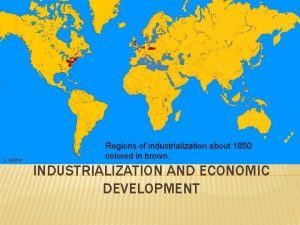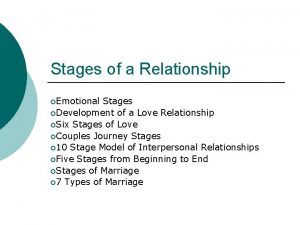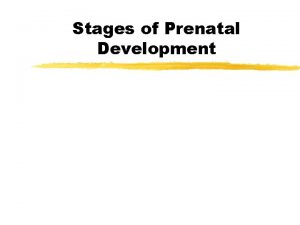Rostows Model of The Stages of Economic Development




















- Slides: 20

Rostow's Model of The Stages of Economic Development

2 ALE RT! Test / E Que s xam Sum m t ion : a r ize R econ osto omi c m ode deve w’s lopm l AN D exp ent you t hink l are t ai n what prob he lems or l im w it h it. it atio ns

The ECONOMY: The means by which a society applies its (limited) resources to satisfy its (unlimited) needs and wants The system of production and distribution and consumption The combined business and work done by a community. The human processes by which Nature’s resources are converted into goods and services. A country's industry, trade and finance.

We lo into t ve to div "dev he "deve ide natio e n l and loping, " oped" an s " " and third wor first worl d "peri ld, " o d" p r hery "core All o. " " f the se la off o f b deve judging els are b a the q lopment, country ased 's uesti but t h o is rai n: Wha ses t e x actly to be does "dev elop it me W hy e an d? ” h a v deve e so m have loped w e coun hile not? othe tries rs

What is Economic Development? Economic development occurs with the reduction and elimination of poverty, inequality and unemployment within a growing economy. Theories of economic growth try to explain how and why the economy expands. The Rostow Linear Stages Model: A linear theory of development. It argues that to achieve modernity all countries pass through the same stages of development. Economies divided into primary, secondary, and tertiary sectors. The history of developed countries suggests a common pattern of structural change.

In 1960, the American Economic Historian, Walt Whitman Rostow suggested that countries passed through five stages of economic development. 1916– 2003

Stage 1 Traditional Society The economy is dominated by subsistence activity where output is consumed by producers rather than traded. Any trade is carried out by barter where goods are exchanged directly for other goods. Agriculture is the most important industry and production is labour intensive using only limited quantities of capital.

Stage 2 Transitional Stage (the preconditions for takeoff) Increased specialisation generates surpluses for trading. There is an emergence of a transport infrastructure to support trade. As incomes, savings and investment grow entrepreneurs emerge. External trade also occurs concentrating on primary products.

Stage 3: Take Off Industrialisation increases, with workers switching from the agricultural sector to the manufacturing sector. Growth is concentrated in a few regions of the country and in one or two manufacturing industries. The level of investment reaches over 10% of GNP.

The economic transitions are accompanied by the evolution of new political, economic and social institutions that support the industrialisation. Ex: Bank of Canada - 1935 The growth is self-sustaining as investment leads to increasing incomes in turn generating more savings to finance further investment. It’s the old upward economic spiral – Canada in the 1920 s.

Stage 4 Drive to Maturity The economy is diversifying into new areas. Technological innovation is providing a diverse range of investment opportunities. The economy is producing a wide range of goods and services and there is less reliance on imports.

Stage 5 High Mass Consumption The economy is geared towards mass consumption. The service sector becomes increasingly dominant. Increasing emphasis on “knowledge-based” industries Increased awareness of environmental issues

Ro st o w’s M od el -1 http: //www 2. hmc. edu/~olson/7

According to Rostow development requires substantial investment in capital: 1. Financial assets or the financial value of assets, such as cash. 2. The factories, machinery and equipment owned by a business and used in production. In general, it refers to financial resources available for use. Companies and societies with more capital are better off than those with less capita For economies to grow the right conditions for such investment would have to be created. Such conditions may include the stable provision of financial services – savings, credit, a stable internationally traded currency.

M aj o r Cri t ic is m s 15

Limitations Many development economists argue that Rostow's model was developed with Western cultures in mind and not applicable to countries in the periphery today. Rostow disregards one of the most fundamental geographical principals: site and situation. Rostow assumes that all countries have an equal chance to develop, without regard to population size, availability and type of natural resources, or location. Singapore, e. g. , has one of the world's busiest trading ports, but this would not be possible without its advantageous geography as an island nation between Indonesia and Malaysia

Problem with Models In reality, policy makers are unable to clearly identify stages as they merge together. As a predictive model it is not very helpful. * future is always unknowable… too many variables * based on conjecture Also, models always generalize ~ Conjecture: an opinion or conclusion formed on the basis of incomplete information

18 There may be priorities other than “growth”, the simple increase in per capita income over and above the rate of population growth. Different societies bound to have different cultural goals, different values Conceive of progress differently, conceive of the ideal end to society differently Assumes that all countries have a desire to develop in the same way, with the end goal of high mass consumption, disregarding the diversity of priorities that each society holds and different measures of development.

In spite of the many critiques to Rostow's model, it is still one of the most widely cited development theories

Despite its significant weaknesses, Let’s Apply!!! What Stage are the Following Countries in? Country GNI A 600 91 3 B 750 70 14 C 10600 18 27 D 8000 13 34 E 950 57 10 F 30200 3 19 29 16 G 3500 % Agric. % Manufac.
 Rostows stages of economic growth
Rostows stages of economic growth Rostows stages of growth
Rostows stages of growth W. w. rostow
W. w. rostow Rostows modernization model
Rostows modernization model Economic growth vs economic development
Economic growth vs economic development Economic growth vs economic development
Economic growth vs economic development Rostows teori
Rostows teori Dtm ladder
Dtm ladder What are the 5 stages of rostow's model
What are the 5 stages of rostow's model The five functional stages development model
The five functional stages development model Lesson 2 our economic choices
Lesson 2 our economic choices National development
National development Rostow's development model
Rostow's development model Rostow stages of economic growth ppt
Rostow stages of economic growth ppt Hát kết hợp bộ gõ cơ thể
Hát kết hợp bộ gõ cơ thể Bổ thể
Bổ thể Tỉ lệ cơ thể trẻ em
Tỉ lệ cơ thể trẻ em Gấu đi như thế nào
Gấu đi như thế nào Chụp phim tư thế worms-breton
Chụp phim tư thế worms-breton Chúa sống lại
Chúa sống lại
